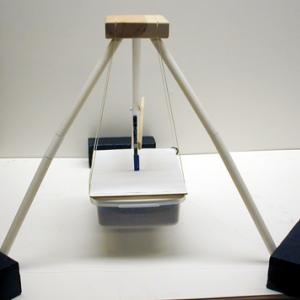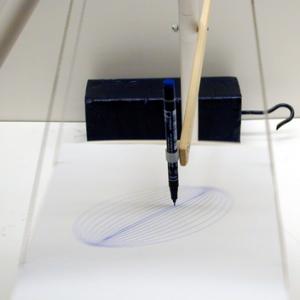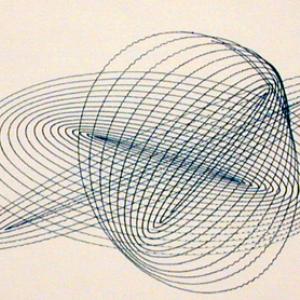College of Liberal Arts & Sciences
3A80.43 - Lissajous Figures - Harmonograph
Set the apparatus up as shown. Brace the corners with the blocks so that the apparatus does not move around when the pendulum is in motion. Set the pendulum in motion with a large amplitude, then carefully drop the pen onto the paper. For multiple patterns, set the pendulum in motion in a different plane and then drop the pen again.
This pendulum is stored at 3A80.10 in the "Oscillations / Acoustics" section. The wooden sand pendulum will trace patterns in the sand when the pendulum bob is adjusted to the right height. Consult the instructions for info on how to spread the sand into a concave shape.
- Thomas B. Greenslade Jr., "The Taut Wire Harmonograph", TPT, Vol. 59, #9, Dec. 2021, p. 724.
- Christopher Chiaverina, "Phosphorescent Drawing Pendulum", TPT, Vol. 44, #4, Apr. 2006, p. 246.
- Thomas B. Greenslade Jr., "Devices to Illustrate Lissajous Figures", TPT, Vol. 41, #9, Sept. 2003, p. 351.
- Thomas B. Greenslade, Jr., "The Double-Elliptic Harmonograph", TPT, Vol. 36, #2, Feb. 1998, p. 90.
- Thomas B. Greenslade, "All About Lissajous Figures", TPT, Vol. 31, #6, Sept. 1993, p. 364.
- Thomas B. Greenslade, Jr., "The Kaleidophone", TPT, Vol. 30, #1, Jan. 1992, p. 38.
- O. Herrera, "Mechanical Device to Draw Lissajous Figures", TPT, Vol. 29, #5, May 1991, p. 284.
- Henry Levinstein, "The Physics of Toys", TPT, Vol. 20, #6, Sept. 1982, p. 358, also a Potpourri of Physics Teaching Ideas - Toys, p. 269.
- Thomas B. Greenslade, Jr., "Harmonographs", TPT, Vol. 17, #4 , Apr. 1979, p. 256.
- Thomas B. Greenslade, Jr., "Lissajous Figure Drawing Device (Photo)", AJP, Vol. 70, #8, Aug. 2002, p. 797.
- Robert J. Whitaker, "Harmonographs. II. Circular Design", AJP, Vol. 69, #2, Feb. 2001, p. 174.
- Robert J. Whitaker, "Harmonographs. I. Pendulum Design", AJP, Vol. 69, #2, Feb. 2001, p. 162.
- W. Herreman, H. Notebaert, "Mechanical Demonstration of Lissajous Figures", AJP, Vol. 47. #11, Nov. 1979, p. 1014.
- David M. Eakin, "Lissajous Art Machine", AJP, Vol. 39, #3, March 1971, p. 347.
- R. H. Romer, "A Double Pendulum 'Art Machine'", AJP, Vol. 38, #9, Sep. 1970, p. 1116.
- C. L. Stong, "Zany Mechanical Devices That Draw the Figures Known As Harmonograms", The Amateur Scientist, May, 1965.
- C. L. Stong, "Water Droplets That Float on Water, and Lissajous Figures Made with a Pendulum", The Amateur Scientist, August, 1973.
- A. D. Bulman, "A Pfaundler Spring Apparatus", Model-Making for Physics, p. 95.
- A. D. Bulman, "A Harmonograph", Model-Making for Physics, p. 86.
- A. D. Bulman, "Compounded Harmonic Motions", Model-Making for Physics, p. 82.
- George M. Hopkins', "Quadruple Compound Harmonic Motion", Experimental Science, Volume Two, p. 420.
- R. W. Pohl, "5. Motion in an Ellipse: Elliptically Polarized Vibrations", Physical Principles of Mechanics and Acoustics, p. 56.
- "Drawing Board", Exploratorium Science Snackbook.
- Raymond Bruman, "Harmonograph", Exploratorium Cookbook I, p. 76.1 - 76.4.
- Raymond Bruman, "Relative Motion", Exploratorium Cookbook I, p. 77.1 - 77.4.
Disclaimer: These demonstrations are provided only for illustrative use by persons affiliated with The University of Iowa and only under the direction of a trained instructor or physicist. The University of Iowa is not responsible for demonstrations performed by those using their own equipment or who choose to use this reference material for their own purpose. The demonstrations included here are within the public domain and can be found in materials contained in libraries, bookstores, and through electronic sources. Performing all or any portion of any of these demonstrations, with or without revisions not depicted here entails inherent risks. These risks include, without limitation, bodily injury (and possibly death), including risks to health that may be temporary or permanent and that may exacerbate a pre-existing medical condition; and property loss or damage. Anyone performing any part of these demonstrations, even with revisions, knowingly and voluntarily assumes all risks associated with them.


